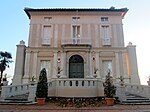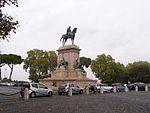Regina Coeli (Latin for '"Queen of Heaven"'; Italian: Carcere di Regina Coeli [ˈkartʃere di reˈdʒiːna ˈtʃɛːli]) is the best known prison in the city of Rome. Previously a Catholic convent (hence the name), it was built in 1654 in the rione of Trastevere. It started to serve as a prison in 1881.
The construction was started by Pope Urban VIII in 1642, but his death stopped the works and the complex remained unfinished. Between 1810 and 1814 the former Catholic convent was confiscated by Napoleonic French forces, who suppressed all religious orders in territories under French control during the Napoleonic Wars. While the complex was returned to Carmelite nuns shortly afterwards, they abandoned the convent in 1873. The newly established Kingdom of Italy confiscated the complex and decided to turn it into a prison in 1881. The refurbishing was carried out by Carlo Morgini and was completed only in 1900. A new complex housing a prison for women, dubbed "Le Mantellate" was erected nearby on a place also formerly occupied by a Catholic convent. Regina Coeli replaced the Carceri Nuove as Rome's primary jail.
While serving as a prison and jail, since 1902 the Regina Coeli also served as a police academy and one of the first schools in Italy to focus on forensics and criminal anthropology. During the times of Fascist Italy the prison served for detention of political prisoners. In 1943, the Nazis led by Erich Priebke rounded up and imprisoned over 1,000 Roman Jews in the Regina Coeli prison. Priebke also perpetrated the Ardeatine Massacre, many of the prisoners at Via Tasso and Regina Coeli prison who happened to be available at the time were massacred by the Nazis at the Fosse Ardeatine to fill the numerical quota set as retaliation for a partisan attack that killed 33 German SS policemen.
Pankratius Pfeiffer, Superior General of the Salvatorians and "the Angel of Rome", is said to have visited the prisons of Regina Coeli and Via Tasso everyday during the Nazi occupation of Rome in 1943 and 1944, returning with a freed prisoner, since he acted as an intermediary between Pope Pius XII and the German authorities. In this capacity, he rescued hundreds of Jews and others in Rome from execution by the Nazis. He also persuaded the Nazis to spare several Italian cities from destruction during their retreat from Italy.
On December 26, 1958, Pope John XXIII visited the prison, washing the feet of several prisoners. This act was repeated by Pope Paul VI in 1964, Pope John Paul II in 2000, and Pope Francis in 2018.In 1979, the prison was bombed by the Movimento Rivoluzionario Popolare, a neo-fascist organisation.
During the theft of the Santo Bambino of Aracoeli on 1 February 1994, inmates at the Regina Coeli prison wrote a petition to their anonymous "colleagues", asking for its return.
In modern times the prison complex can house up to 900 detainees.











